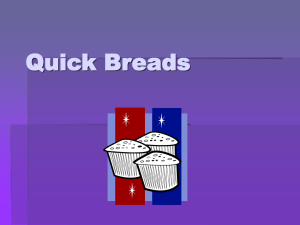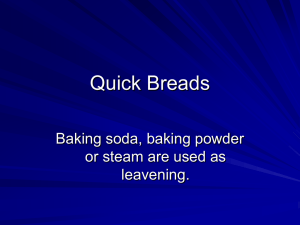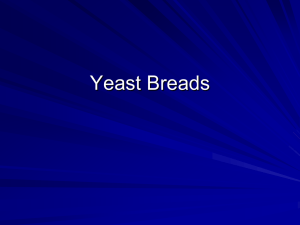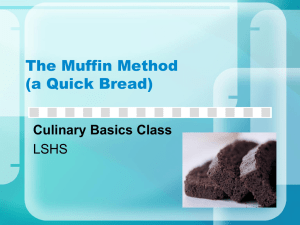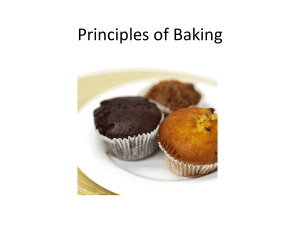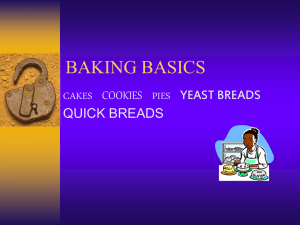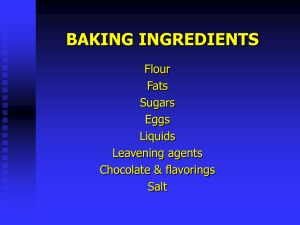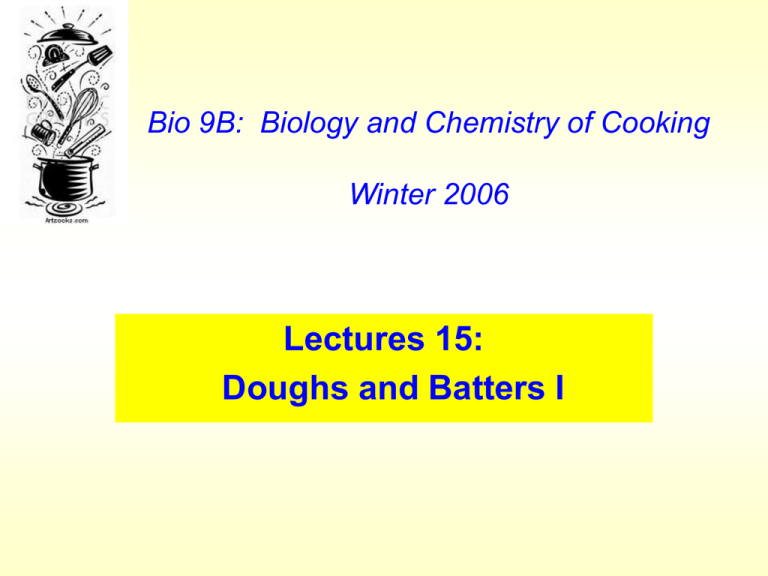
Bio 9B: Biology and Chemistry of Cooking
Winter 2006
Lectures 15:
Doughs and Batters I
Doughs and Batters: Breads and Cakes
“Doughs”
– Contain more flour than water
– Stiff and pliable
– All water bound up in starch and gluten
“Batters”
– Contain more water than flour
– Pourable
– Much of the water is free liquid
Copyright © 2006 Dr. Salme Taagepera,
All rights reserved.
Lecture 15
DOUGHS AND BATTERS I & II:
"All you knead to know about bread"
I.
Raised breads dependent on unique characteristics of
wheat flour
II.
Gluten development
III.
Leavening involves production of CO2 gas
IV.
Additional ingredients in doughs
V.
Preparing the dough
VI.
Other dough products
VII.
Batters
Copyright © 2006 Dr. Salme Taagepera,
All rights reserved.
Doughs and Batters
I.
Raised breads dependent on unique
characteristics of wheat flour
A.
Types of wheat flours: hard v. soft
B.
Wheat flour components
-major components:
= gluten proteins (glutenin and gliaden), starch
-minor components:
= lipids, carbohydrates, enzymes
Copyright © 2006 Dr. Salme Taagepera,
All rights reserved.
Flour is milled and sieved from wheat
• Most flours are refined
– Oil-rich bran and germ are removed
– Starch/protein-rich endosperm purified
• Two types of milling
– Conventional (Theo kiểu truyền thống)
– Stone-ground (Nghiền đá)
Copyright © 2006 Dr. Salme Taagepera,
All rights reserved.
Components of flour
• Major components
– Starch (70%)
– Proteins (gluten proteins)
• Glutenin: elasticity (Đàn hồi) = resistance, “bounceback” (Chịu tác động cơ học)
• Gliadin: plasticity (Mềm dẻo) = “stretchability” (Chịu
kéo)
• Minor components
– Lipids
– Other carbohydrates
Dr. Salme Taagepera,
– Enzymes Copyright ©All2006
rights reserved.
Levels gluten proteins determine
characteristics of different flour types
Flour
type
Wheat
type
Protein Starch
content Content
Cake
soft
7-8%
70-80%
low
All
Purpose
soft /
hard
8.511.5%
70-80%
middle
Bread
hard
12-13% 70-80%
Copyright © 2006 Dr. Salme Taagepera,
All rights reserved.
Water
absorption
high
Doughs and Batters
I. Raised breads dependent on unique characteristics
of wheat flour
A. Types of wheat flours: hard v. soft
B. Wheat flour components
-major components: gluten proteins (glutenin and gliaden),
starch
-minor components: lipids, carbohydrates, enzymes
II. Gluten development
A. Balance of plasticity (stretchability) and elasticity (resistance)
B. Kneading: promotes unfolding (duỗi thẳng) and aligning (thẳng
hàng) of gluten molecules
C. Dough breakdown: excessive kneading results in loss of
crossbridges (Nhào quá nhiều sẽ dẫn đến các liên kết sẽ bị gãy
vỡ _ 6 giai đoạn nhào)
Copyright © 2006 Dr. Salme Taagepera,
All rights reserved.
Not just a single simple protein: made from a
network of large interacting proteins
1. Glutenin
–
long coiled chain (các lk cuộn lại với nhau)
–
interact with each other in several ways
(Tương tác với nhau bằng nhiều cách)
–
contributes elasticity “bounce-back” to dough
(Tăng sự đàn hồi trong khối bột nhào)
2. Gliadin
glutenin
C-SH
HS-C
H-O
gliadin
–
compact and folded in on themselves
(Gắn kết và cuộn lại trong nhau)
–
little interaction with each other
–
contributes plasticity “stretchiness” to dough
(Tăng sự mềm dẽo, kéo dãn trong khối bột nhào)
Copyright © 2006 Dr. Salme Taagepera,
All rights reserved.
Demonstration of plasticity
Demonstration elasticity
gliadin
glutenin
C-SH
HS-C
H-O
http://www.fao.org/docrep/V5380E/V5380E0O.GIF
Copyright © 2006 Dr. Salme Taagepera,
All rights reserved.
Gluten Development
glutenin
HS-C
gliadin
C-SH
H-O
Gliadin
interrupts
glutenins
After adding water and kneading:
H
O
C-S-S-C
H
N
c
cc
c
c
cc
c
H
N
c C-S-S-C
cc
c
C-S-S-C
Proteins
absorb water
H
O
C-S-S-C
Hydrophobic
interactions
Disulfide bonds
Copyright © 2006 Dr. Salme Taagepera,
All rights reserved.
Hydrogen
bonding
Components of flour
• Major components:
– Starch (70%)
– Proteins (gluten proteins)
• Glutenin: elasticity = resistance, “bounce-back”
• Gliadin: plasticity = “stretchability”
Copyright © 2006 Dr. Salme Taagepera,
All rights reserved.
Components of flour: starch
• 70% of flour is starch
• Breaks up gluten network
– tenderizes final product
(Làm mềm sản phẩm cuối cùng)
• Starch granules swell (phồng) and set upon
baking
– provides the structural bulk of baked bread/cake
(Tạo cấu trúc bánh)
• Some converted to sugars via enzymes
– feeds the yeast
Copyright © 2006 Dr. Salme Taagepera,
All rights reserved.
Components of flour
• Major components
– Starch (70%)
– Proteins (gluten proteins)
• Glutenin: elasticity = resistance, “bounce-back”
• Gliadin: plasticity = “stretchability”
• Minor components
– Lipids
– Other carbohydrates
– Enzymes
Copyright © 2006 Dr. Salme Taagepera,
All rights reserved.
Components of flour: lipids
Fats and oils:
• “shorten” glutenin network
– Interacts (tương tác) with
glutenins, weakening glutenin
intermolecular bonding
•
lubricate gluten sheets
– fat separates thin layers of dough
– Allows for sliding (trượt) and
expansion (contributes to
plasticity)
Copyright © 2006 Dr. Salme Taagepera,
All rights reserved.
Components of flour
• Major components
– Starch (70%)
– Proteins (gluten proteins)
• Glutenin: elasticity = resistance, “bounce-back”
• Gliadin: plasticity = “stretchability”
• Minor components
– Lipids
– Other carbohydrates
– Enzymes
Copyright © 2006 Dr. Salme Taagepera,
All rights reserved.
Components of flour: enzymes
1.
Malt enzymes
– Break down starch into sugars
– Normally activated in wheat when
embryo growth begins
2.
Proteases
– Slowly digest gluten proteins
– Inhibit protease enzyme activity
with salt
Copyright © 2006 Dr. Salme Taagepera,
All rights reserved.
http://www.mosquitonet.com/~stihlerunits/ScottsDen/Beer/Hmbrewi
http://www.bioafrica.net/proteomics/PR-320x240-anim.gif
ng/acrospire.jpg
Doughs and Batters
I.
Raised breads dependent on unique
characteristics of wheat flour
II. Gluten development
III. Leavening involves production of CO2 gas
A. Biological leavening: yeast (bread)
B. Chemical leavening: baking soda and powder (cakes)
Copyright © 2006 Dr. Salme Taagepera,
All rights reserved.
Leavening: gas bubbles!
(Làm nở bánh)
• Makes leavened products
light and tender
– 80% of bread’s volume
is empty space
• Divide gluten network
into thin sheets
• Leavening functions by
increasing size of preexisting bubbles
– Introduced through
mixing and kneading
dough
Where do the gas bubbles come from?
Copyright © 2006 Dr. Salme Taagepera,
All rights reserved.
Doughs and Batters
I.
Raised breads dependent on unique
characteristics of wheat flour
II. Gluten development
III. Leavening involves production of CO2 gas
A. Biological leavening: yeast (bread)
B. Chemical leavening: baking soda and powder (cakes)
Copyright © 2006 Dr. Salme Taagepera,
All rights reserved.
Biological leavening: yeast
•
Yeast is a fungus that feeds on sugars
•
The budding yeast (Saccharomyces cerevisiae), is the
common yeast used in
= baking ("baker's yeast")
= brewing ("brewer's yeast")
http://www.genomenewsnetwork.org/gnn_images/news_c
ontent/12_03/yeast/saccharomyces.jpg
Copyright © 2006 Dr. Salme Taagepera,
All rights reserved.
Yeast metabolism is versatile!
1. Aerobic metabolism
C6H12O6
oxygen
CO2 + H2O + ATP
2. Anaerobic metabolism
C6H12O6
C2H5OH + CO2
Copyright © 2006 Dr. Salme Taagepera,
All rights reserved.
Biological leavening: yeast
• Yeast is a fungus that feeds on sugars
• Yeast metabolism produces alcohol and
the gas carbon dioxide
– Cooking destroys the alcohol and kills the
yeast.
– But the bubbles are left behind, and that's why
bread is soft
Copyright © 2006 Dr. Salme Taagepera,
All rights reserved.
Doughs and Batters
I.
Raised breads dependent on unique
characteristics of wheat flour
II. Gluten development
III. Leavening involves production of CO2 gas
A. Biological leavening: yeast (bread)
B. Chemical leavening: baking soda and powder (cakes)
Copyright © 2006 Dr. Salme Taagepera,
All rights reserved.
Demo: Baking Soda Volcano
• Add baking soda and vinegar
Copyright © 2006 Dr. Salme Taagepera,
All rights reserved.
Chemical Leavening: baking soda
Acid + Base ––––> CO2 + H2O + byproduct
– Bases:
• Potash (potassium carbonate)
– Extracted from wood ash
• Baking soda (sodium bicarbonate - NaHCO3)
– Acids:
• Buttermilk, yogurt, brown sugar, vinegar,
chocolate, fruit juices, cream of tartar ( potassium
hydrogen tartrate-tartaric acid)
Copyright © 2006 Dr. Salme Taagepera,
All rights reserved.
Acid - Base reaction
NaHCO3 + CH3COOH
base
acid
CO2 + H2O + Na+ + CH3COO(ions in solution)
The acid and base neutralize
each other and form neutral
carbon dioxide, water, and a
soluble salt
Copyright © 2006 Dr. Salme Taagepera,
All rights reserved.
http://ga.water.usgs.gov/edu/images/phdiagram.gif
Demo: Baking Soda v. Powder
• Two beakers (cốc) of water
– Add spoonful (thìa, muỗng) of baking SODA
• What happens?
– Add spoonful of baking POWDER
• What happens?
• Add a bit of vinegar to the baking soda
– What happens?
Copyright © 2006 Dr. Salme Taagepera,
All rights reserved.
Chemical leavening
1.
Baking soda = Sodium bicarbonate (alkaline)
•
•
2.
Add soda to dough containing acid
Get carbon dioxide!
Baking powder = Baking soda + acid
•
•
Add baking powder to water
Get carbon dioxide!
Copyright © 2006 Dr. Salme Taagepera,
All rights reserved.
Leavening: Baking Powder
Baking Powder contains both base and acid
– Base: baking soda
– Acid: dry crystalline form
• Several different types acid may be present:
– Fast acting - during mixing
» Very soluble acid (ex. Cream of tartar-tartaric acid)
– Slow release after mixing
» Not very soluble (ex. sodium aluminum pyrophosphate
(SAPP))
– Heat activated - during cooking
» Soluble only at specific minimum temperatures
» Ex. Dimagnesium phosphate (DMP) - 40-44C
Copyright © 2006 Dr. Salme Taagepera,
All rights reserved.
DOUGHS AND BATTERS I:
I.
Raised breads dependent on unique characteristics of
wheat flour
II. Gluten development
III. Leavening involves production of CO2 gas
IV. Additional ingredients in doughs
-Shortening: fats and oils that “shorten” gluten
-break up gluten masses, weaken structure so final product is more tender
-Sugar:
-feeds yeast, binds water to moisten bread, involved in browning reactions
-Salt
-inhibits yeast activity, toughens gluten, inhibits gluten proteases
-Milk and eggs
-add flavor and texture
Copyright © 2006 Dr. Salme Taagepera,
All rights reserved.
Dough components -SUMMARY
• Flour = gluten proteins
• Leavening = CO2 to raise bread
• Shortening = increase volume, tender
• Sugar = tender, brown
• Salt =
inhibits gluten proteases
inhibits yeast activity
toughens up gluten proteins
• Eggs/milk = flavor, structure
Copyright © 2006 Dr. Salme Taagepera,
All rights reserved.
Scientific terms/concepts:
• gluten proteins (glutenin and gliaden)
– hydrogen, disulfide, hydrophobic bonds
– elasticity, plasticity
• wheat enzymes: malt enzymes, proteases
• leavening: biological v. chemical, aerobic v. anaerobic
metabolism, acid-base reaction
Copyright © 2006 Dr. Salme Taagepera,
All rights reserved.

